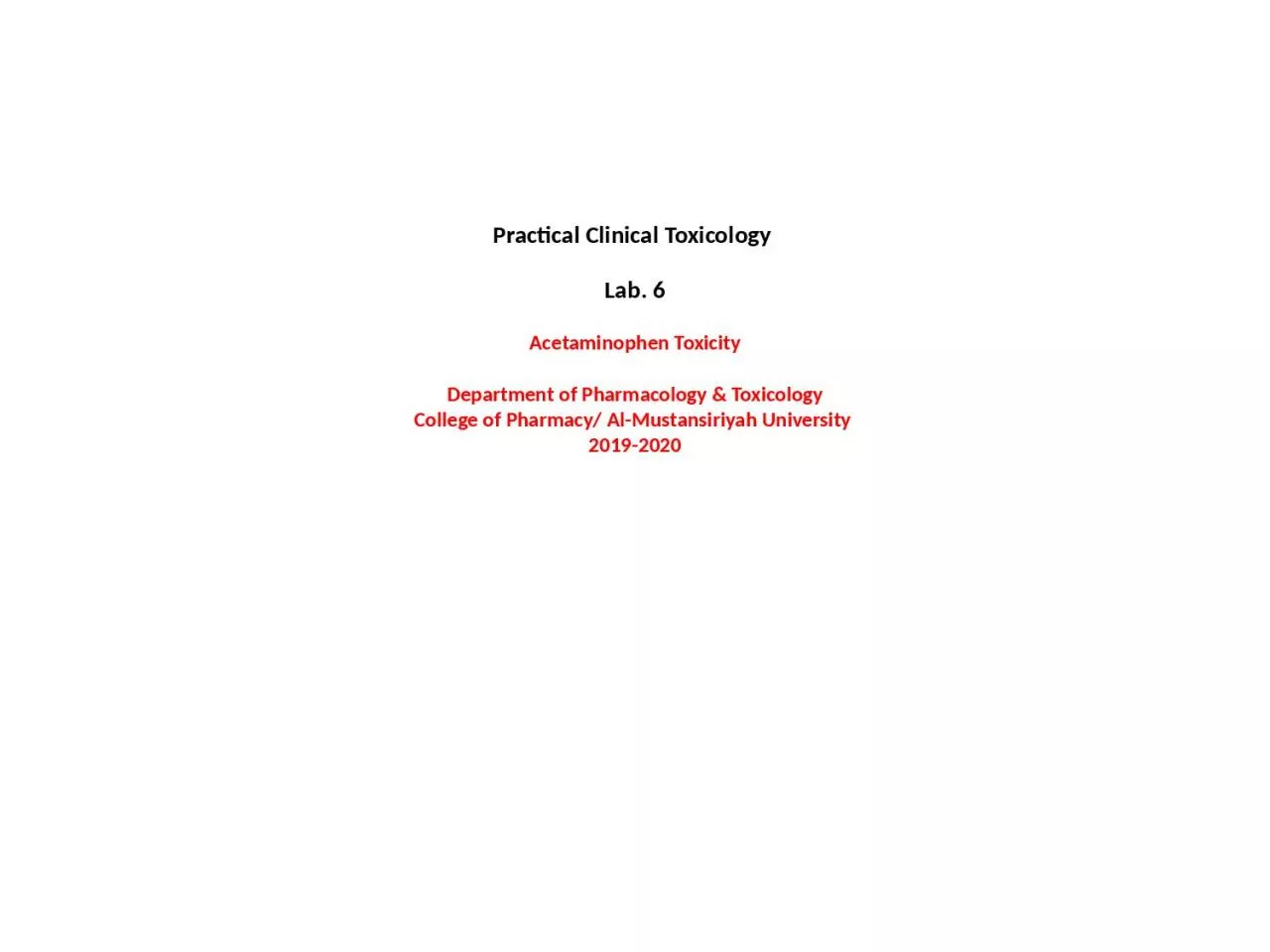

Lab 6 Acetaminophen Toxicity Department of Pharmacology amp Toxicology College of Pharmacy AlMustansiriyah University 20192020 Acetaminophen N acetyl p aminophenol APAP ID: 918464
Download Presentation The PPT/PDF document "Practical Clinical Toxicology" is the property of its rightful owner. Permission is granted to download and print the materials on this web site for personal, non-commercial use only, and to display it on your personal computer provided you do not modify the materials and that you retain all copyright notices contained in the materials. By downloading content from our website, you accept the terms of this agreement.
Slide1
Practical Clinical Toxicology
Lab. 6
Acetaminophen Toxicity
Department of Pharmacology &
Toxicology
College of Pharmacy/ Al-Mustansiriyah University
2019-2020
Slide2Acetaminophen
(
N
-acetyl-
p
-aminophenol [APAP
])
Most
commonly used OTC analgesic and
antipyratic
drug
It has weak anti inflammatory and antiplatelet properties
Antipyresis
and analgesia are predominantly mediated by
the central
indirect COX-2
inhibition
where as
anti inflammatory and
antiplatelets
effect due to
mild,
peripheral
inhibition of
COX-2
and minimal COX-1
inhibition.
Slide3Acetaminophen metabolism
4% is metabolized by the cytochrome P450 mixed-function oxidase system
(CYP
2E1
)
to the potentially toxic reactive intermediate N-acetyl-p-
benzoquinoneimine (NAPQI).
60% glucuronide conjugates30% to sulfate conjugates
conjugated with glutathione to form nontoxic cysteine and mercapturic acid conjugates
LIVER
Slide4Mechanism of toxicity
Nontoxic
sulfation
metabolism of APAP may become
saturated,and the amount of N -acetyl- p
benzoquinoneimine (NAPQI) (toxic metabolite) formed is increased by CYP2E1 and outstrip the supplying of (glutathion)GSH, resulting in free NAPQI rapidly binding to hepatocyte constituents lead to centrilubular
necrosis.Hepatic toxicity becomes evident only when hepatic GSH falls to 30% of baseline
Slide5Slide6Factors
that may predispose patients to
hepatotoxicity:
Increased
frequency and duration of acetaminophen
dosingIncreased capacity for CYP2E1 activation to
NAPQI for example: Long-term treatment with CYP 450 inductors (e.g., carbamazepine, rifampicin) and long term administeration of alcohol.Decreased GSH availability by:people with acute or chronic starvation
Eating disorders (e.g., anorexia or bulimia)Patients with chronic debilitating illnesses (e.g., cystic fibrosis, AIDS, alcoholism, or hepatitis C)Decreased capacity for glucuronidation
and sulfation
Children
Slide7Concentrations of acetaminophen and their interpretation
Slide8Clinical Manifestations
Stage II toxicity
24 to 72hours,
right upper quadrant abdominal pain, anorexia,
N/V,
Tachycardia
and hypotension
, Raised liver function test
Stage II
I
toxicity
72
to
96 hours, N/V/abdominal
pain, Maximal liver
injury (jaundice, coagulopathy,
hypoglycemia
, and hepatic
encephalopathy
), Acute renal
failure,
Death from multiorgan failure
Stage IV toxicity
T
he
recovery phase, Patients who survive
stage III
Slide9Monitoring and Testing
Laboratory
tests
*Serum
acetaminophen levelsManagement is dependent on the serum acetaminophen level and the time of
ingestionRumack/Matthew nomogram or acetaminophen nomogram is an acetaminophen toxicity nomogram plotting serum concentration of acetaminophen against the time since ingestion in an attempt to prognosticate possible liver toxicity as well as allowing a clinician to decide whether to proceed with
N-Acetylcysteine (NAC) treatment or not. Paracetamol concentrations taken between 4 and 24 hours after ingestion. Generally, a serum plasma concentration (APAP) of 140–150 microgram/mL (or milligrams/L) at 4 hours post ingestion, indicates the need for NAC treatment.
Slide10Slide11Cont
…
Liver function tests
alanine aminotransferase [ALT]
aspartate aminotransferase [AST]bilirubin [total and fractionated]
alkaline phosphataseProthrombin time (PT) with international normalized ratio (INR)GlucoseRenal function studies (electrolytes, BUN, creatinine
)
Slide12Treatment of Acetaminophen Overdose
Gastric emptying
Activated charcoal
NAC (
N-
acetylcysteine),antidote given orally, from 4-8 hrs
from ingestion. It is a sulfhydryl donor, replenishes glutathione stores Loading dose of 140 mg/kg then 70 mg/kg given every 4 hours Total
treatment duration of 72 hours It causes vomiting when given by mouth or nausea when given intravenously Asthma, this treated by interrupting the
acetylcysteine infusion and providing symptomatic relief with an antihistamine such as chlorpheniramine
and nebulized salbutamol.
Liver
transplantation, for patients with severe hepatotoxicity and potential to progress to hepatic
failure, Metabolic acidosis, Renal failure, Coagulopathy
and Encephalopathy
Slide13